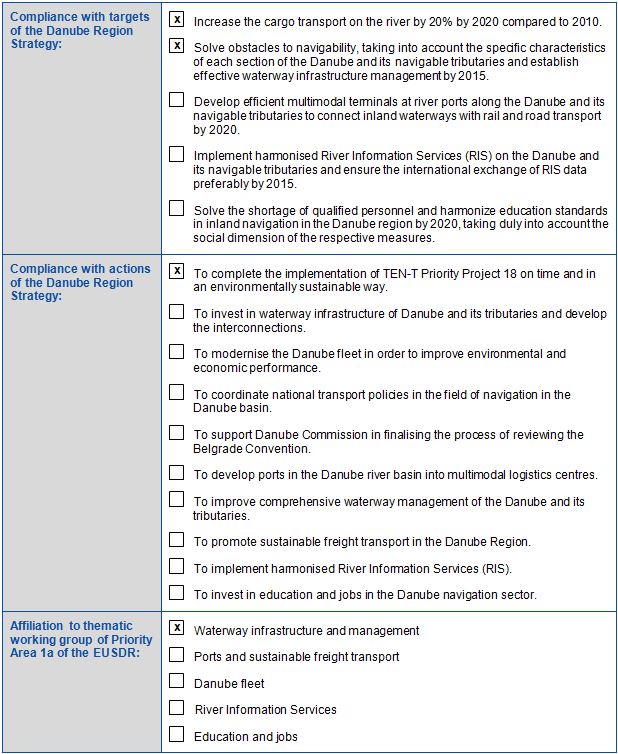BASIC PROJECT DATA
Project ID: PA1A070
NEED AND ADDED VALUE FOR THE DANUBE REGION STRATEGY
The construction of the rail/road bridge across the Danube in Novi Sad was one of the priority projects in the Master Plan for IWW Transport in Serbia (2006).
The old Zezelj bridge was destroyed in NATO air strikes in 1999. The temporary constructed bridge did not comply with the required standards of the Danube Commission and EU standards. The new Zezelj bridge (within the European Rhine-Danube Corridor) was reconstructed until 2018 at the same location using the foundation of the bombed bridge.
OBJECTIVE(S) OF THE PROJECT
- Integration into the European Railway Transport Network, efficient and improved railway connection which results in increased interoperability between the Balkan area and the EU, using EU standards.
- Elimination the bottleneck on the European Rhine-Danube Corridor, as the temporary bridge represented an obstacle for navigation (limited heights at high water levels, limited fairway width due to curve radius)
CONDUCTED PROJECT ACTIVITIES
1. Construction of the new bridge according to FIDIC Red Book specifications:
- Replacement of the existing temporary bridge with a new bridge for road and rail transport
- Creation of the appropriate width of the fairway in line with Danube Commission standards, which results in efficient navigation on the Danube and increases transport safety
2. Supervision of construction of the new bridge according to FIDIC Yellow Book:
- Daily supervision during the execution of the works
TRANSBOUNDARY IMPACT
The river traffic on the Serbian part of the Danube is mainly transit from the Black Sea to Hungary, Austria and Germany. Consequently, there is a noted benefit for the EU to keep this corridor functional and guarantee safe and efficient navigation. The implementation of the new bridge as part of this European network Corridor enhanced this. The bridge improves and enhances the railway connection.
PROJECT BENEFICIARIES / TARGET GROUPS
The main beneficiaries of this project are the waterway users, the City of Novi Sad and Serbian Railways.
STATUS AND TIMEFRAME
Start date: 03/2011
End date: 08/2018
The project is already concluded.
NOTES
On 20 April 2012, Serbian Railways was granted the permission to start construction works on the bridge. The estimated project implementation period was 32 months. The bridge was re-opened on 01.09.2018.
FINANCING
Total budget: 60,000,000 EUR
EU funds: 30,300,000 EUR for construction of bridge
funded by Instrument for Pre-Accession Assistance (IPA) 2009
4,100,000 EUR for construction of Zezelj Bridge Access Roads
funded by Instrument for Pre-Accession Assistance (IPA) 2011
National funds: not disclosed (Autonomous Province of Vojvodina)
4,000,000 EUR (City of Novi Sad)
PROJECT TEAM
Project leader: Serbian Railways / Serbia (website: www.zeleznicesrbije.com)
Address: Nemanjina 6, 11000 Belgrade / Serbia
Project partner(s):
Contractor to perform works: Spanish-Italian consortium consisting of:
- AZVI (Spain)
- Tadei (Italy)
- Horta Koslada (Spain)
PROJECT ENVIRONMENT
PROJECT CROSS – REFERENCE
Construction of Zezelj Bridge Access Roads in IPA 2011.
STRATEGIC REFERENCE
Serbian strategic framework:
- Master Plan for IWW Transport in Serbia (2006)
- Serbian Transport Development Strategy for Period 2008-1015 (2008)
- General Master Plan for Transport in Serbia (2009)
International strategic framework:
- EU Strategy for the Danube Region
- Recommendations of the Danube Commission
- AGN (UNECE)
EUSDR EMBEDDING
EUSDR COMPLIANCE
META DATA
Data provided by: Ivan Mitrovic (Plovput, Serbia) – 09.03.2012
Last update based on Rhine-Danube Corridor Study (via donau, Austria) – 03.07.2017
Download pdf



